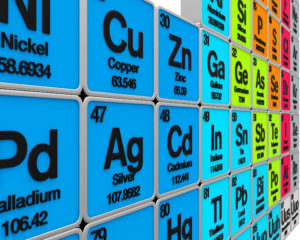
The periodic table is one of the most pivotal and enduring tools of modern science. It’s seen from the inside covers of elementary science textbooks to the walls of chemistry labs all around the world. To honor the 150th anniversary of its discovery, the United Nations General Assembly and UNESCO have declared 2019 to be the International Year of the Periodic Table of Chemical Elements.
As with all scientific progress, Dmitri Mendeleev’s periodic table was the result of decades—centuries, even—of research performed by scientists all over the world. Aristotle first theorized the existence of basic building blocks of matter over 2,500 years ago, which later were believed to be earth, air, fire and water. Alchemist Hennig Brand is credited with discovering phosphorus in the late 17th century, sparking chemists to begin pursuing these basic atomic elements.
By the 1860s, over sixty elements had been identified and scientists were looking for a logical way to organize them. In 1862, French geologist Alexandre Beguyer de Chancourtois plotted the known elements by weight onto a vertical cylinder, resulting in a helix shape. While the so-called telluric screw failed to reflect all known trends and properties of the elements, it showed elements with similar properties in a vertical line, or periodically. While his work went largely unnoticed for several years, following Mendeleev’s publication, de Chancourtois gained moderate recognition as the first to demonstrate the periodicity of the elements.
English chemist John Newlands, on the other hand, was largely unrecognized for his contributions until the late 20th century. In 1864, five years before Mendeleev, Newlands devised what he called the “Law of Octaves.” In short, he found that when arranged by atomic weight, every eighth element would share properties. This was an important step in generalizing the trends of the elements, but unfortunately the table he generated using his theory was inaccurate and misguided. To make everything fit together, some elements had to share boxes, while other boxes were left empty. Newlands was ridiculed and shunned by most institutions and spent the later parts of his life fighting for recognition. However, in 1998, the Royal Society of Chemistry chose to formally acknowledge the contributions Newlands made to the modern periodic table by placing a plaque at his birthplace describing him as a “Chemist and discoverer of the Periodic Law for the chemical elements.”
Of course, the contributions of countless scientists culminated with the 1869 publication of Dmitri Mendeleev’s periodic table. Like the others, his system ordered the elements by atomic weight, but Mendeleev noticed that this method wasn’t a perfect predictor for properties. For example, a strict order by weight would place Iodine with the chalcogens (Oxygen group) and Tellurium with the halogens, while Mendeleev knew that each shared more properties with the other group. He changed the order to reflect these known properties, and even left five open spaces to reflect elements he predicted would eventually be discovered. His gamble paid off when three of these spaces were filled in the fifteen years following his publication (Gallium, Scandium and Germanium were discovered by 1884).
Besides predicting several new elements, Mendeleev’s table also withstood the paradigm shift when scientists like Henry Moseley began to work with atomic numbers. Using cutting-edge X-ray techniques in the early 20th century, Moseley found a way to directly measure atomic number. This finally explained why Mendeleev was correct to switch elements like Tellurium (n=52) and Iodine (n=53) instead of strictly ordering them by weight.
150 years later, Mendeleev’s periodic table is still holding strong. Since first published in 1869, the table has grown with 55 new additions. We’ve discovered the famously nonreactive noble gases and synthesized extremely radioactive elements with no stable isotopes. The last row of the periodic table was completed in 2016 when IUPAC and IUPAP officially approved the naming of Oganesson (n=118), one of only two elements named for a living scientist.
While he never won a Nobel Prize, Dmitri Mendeleev has been immortalized as the namesake of element 101, Mendelevium, and lionized as the father of the periodic table. The International Year of the Periodic Table of Chemical Elements will feature commemorative events around the world, including many hosted by the American Chemical Society in the United States. To read more about the history of the periodic table and keep up with all the action, visit IYPT2019.org.
Latest posts by Jordan Villanueva (see all)
- Tackling Undrugged Proteins with the Promega Academic Access Program - March 4, 2025
- Academic Access to Cutting-Edge Tools Fuels Macular Degeneration Discovery - December 3, 2024
- Novel Promega Enzyme Tackles Biggest Challenge in DNA Forensics - November 7, 2024
